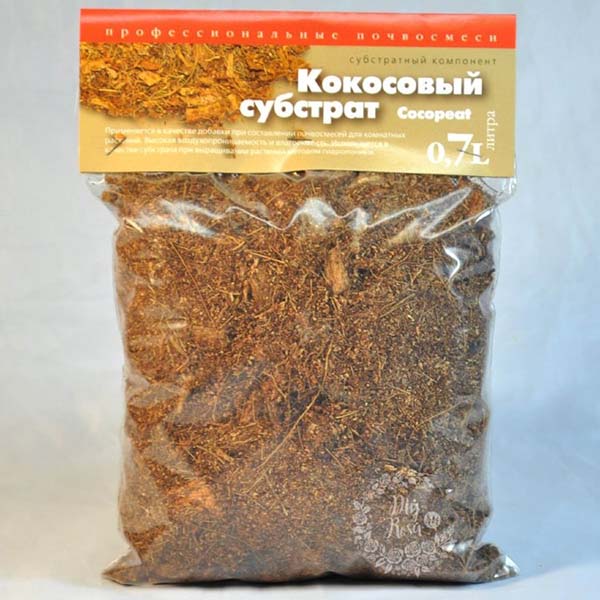Planting astilba in open ground: rules of care and cultivation
Isn't it because we are so eager to go to the dacha in the summer that we are madly attracted by the mythically fabulous world of ornamental plants. Among them, astilba stands out - the bright queen of the shady garden, which, as if bewitching with its multi-colored lush Christmas trees, and makes you sincerely wait for magic. It is difficult to imagine any garden without this plant. It looks very picturesque in spring, when lace leaves of various shades appear, and during colorful summer flowering, and after it in autumn, preserving shiny beautiful leaves until the very end of the season. He has a unique, as if honey, aroma.
Astilba is one of the most unpretentious plants that can survive in the harshest conditions. Therefore, it is often called a plant for novice gardeners.

Content
Types and varieties of astilba
The most popular types and varieties of astilbe can be grouped into the following:
- Arends (Amethyst, Brautschleier, Fainel, White and Weiss, Gloria,Gloria Purpurea, Color Flash, Color Flash Lime, Erica);
- Chinese (Vision Series, Hip Hop, Veronica Klose, Superba);
- Thunberg (Straussenfeder);
- Japanese (Montgomery, Bronzelaub);
- Curly (Lilliputian, Perqueo, Moulin Rouge).
As for the choice of the height of the astilbe, then if you want to plant a shrub in the background of a flower bed or to a fence, then it is better to choose a higher variety. For example, the variety Amethyst Is the perfect choice.
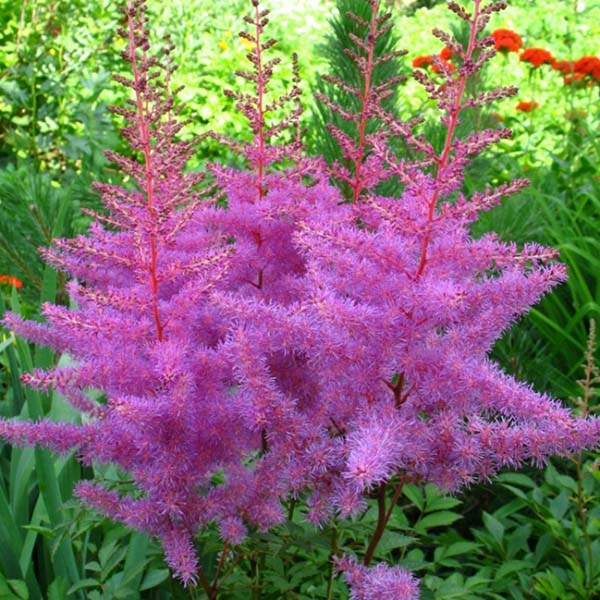
If astilba is needed for a mini-garden, then miniature (dwarf, ground cover) varieties are suitable for you, for example, Lilliputian or Perkeo.
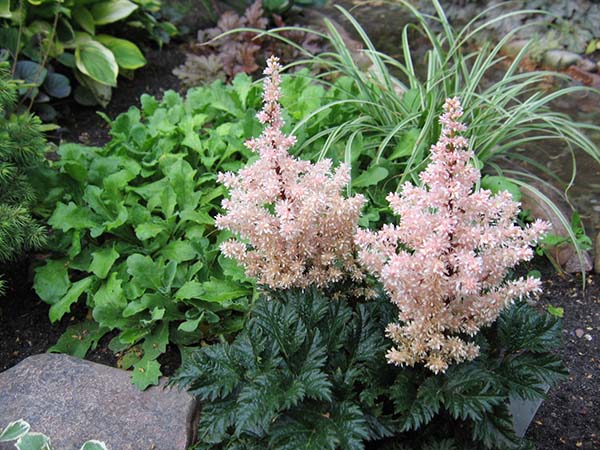
When designing a flower garden, it is important to take into account the shape of the inflorescences. It is also very diverse in astilbe, for example, in the variety Aphrodite and Ericaflowers are very airy and rhombic.

And the seriesVisionon the contrary, the flowers are very dense and powerful.
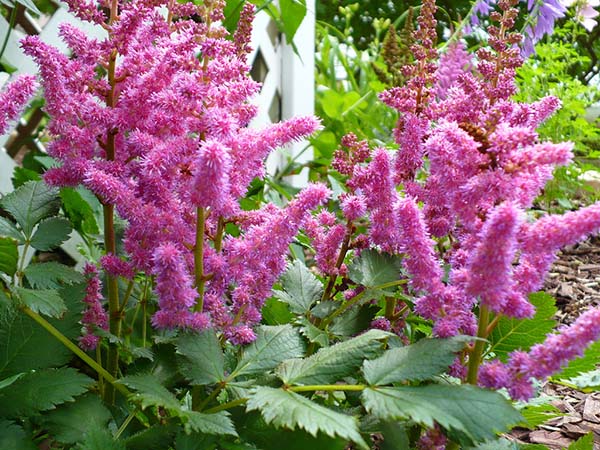
The variety Gloria Purpurea- large and fluffy.
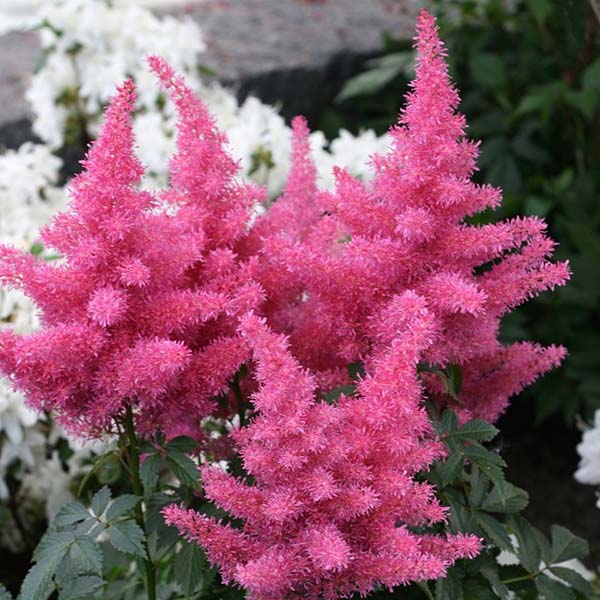
Very original inflorescences of the variety Straussenfeder - similar to large and drooping ostrich feathers.
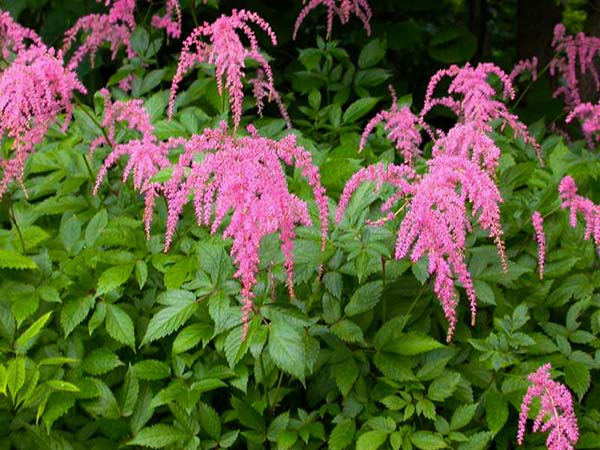
Astilba breeding methods
Astilba can be propagated in several ways:
- seeds (for the species);
- dividing the bush (for the variety);
- renewal buds with part of the rhizomes (for the variety).
Reminder! At the garden store, you can purchase seeds and rhizomes with renewal buds. You can propagate by dividing the bush after you grow astilbe from seeds or rhizomes, or your neighbor will share it with you.
Growing astilba from seeds
Planting astilba seeds is easy enough, but growing is not so easy. First, the seeds must necessarily undergo stratification, in other words, the container with the crops will need to be refrigerated for 3 weeks. It is worthwhile to lay the foundation for stratification in January.
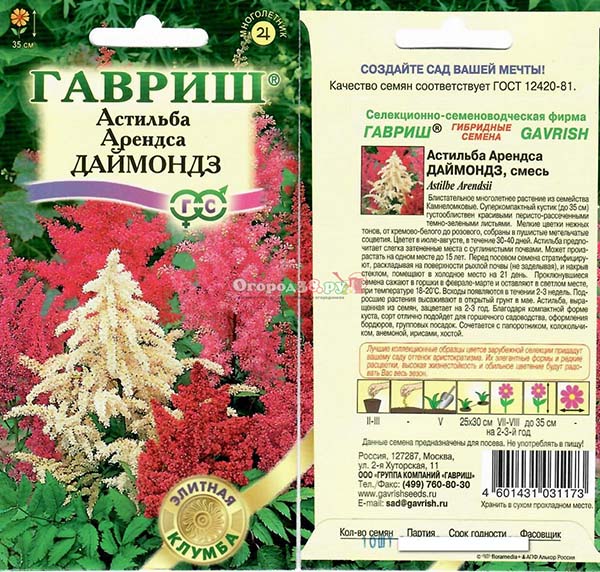
For sowing, you need a loose soil mixture (for example, peat and sand in equal proportions), on top of which you need to evenly distribute astilbe seeds, which are very small, so you will have to use a slightly moistened tooth for planting. At the end of the sowing, lightly sprinkle with cold water from a sprayer (it is possible with the addition of vermicompost for seedlings). And then cover with a plastic bag or film (shoe cover) and put in the refrigerator.
Advice! Experienced growers recommend sprinkling crops with a small layer of snow (1 centimeter) instead of spraying with cold water. And when it has already melted, then put the crops in the refrigerator.
In February and March (depending on when you sowed the seeds), the hatched seeds are already embedded in the ground and the containers are placed in a bright and warm place, where the temperature is about + 18-20 degrees. As a rule, seedlings appear in 2-3 weeks. Further, they are looked after, as well as for ordinary flower seedlings, in other words, they are watered and illuminated until the optimal 12 hour daylight hours. In order not to dive, it is better to immediately sow in individual containers. In May, they are planted in open ground.

Worth knowing! Astilba grown from seed will only bloom in the 2nd or 3rd year!
Video: sowing astilba seed for seedlings
Typically using dividing the bush an overgrown astilba is transplanted, which should be performed at least once every 5 years. The bush should be divided so that each division has from 3 to 5 renewal buds. Astilba can be transplanted in this way both in the spring (preferably early), and at the end of summer (in August) or early autumn. Moreover, it is optimal to plant it at a distance of at least 30-40 centimeters between the bushes.

The most popular way is reproductionkidney renewal and part rhizomes... It is about this method that will be discussed below.
How to keep astilba at home before planting in the ground
If you bought a dormant plant, then you can perfectly keep it in the refrigerator until it is planted in the open ground.
If you see that the growth buds have woken up, that is, the growth process has started, the plant should be placed in a pot of soil as soon as possible, otherwise it will simply have nowhere to take nutrients. Astilba rhizomes are not designed for long-term storage, so if they begin to dry out, then you will hardly be able to grow a healthy plant from these roots.
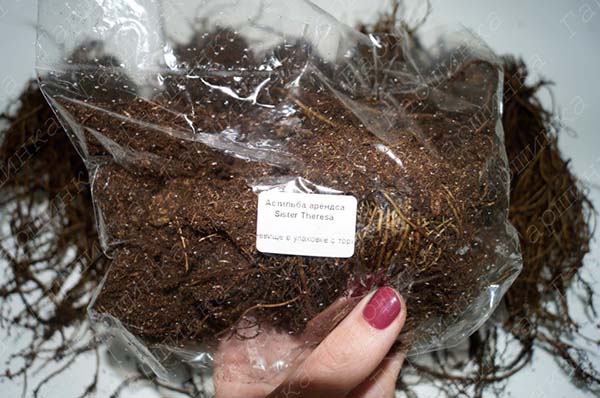
Container and soil
You should take care of purchasing the necessary capacity for planting in advance. It is good to plant astilba in plastic buckets with a volume of about 1 liter. In such a container, it is very convenient to observe the condition of the plant roots and soil moisture.
When it comes to soil, it is best to use a universal flower primer, to which add a little vermiculite to improve soil properties and maintain air-water balance.
By the way! It is not necessary to plant in the ground, it can also be planted in coconut substrate. Its distinguishing characteristic is that it contains a lot of air, which means that the roots, which in February-March, as a rule, are not in very good condition, will receive good development.
Planting in a pot
Step-by-step instructions for planting astilba in a pot to preserve the plant at home:
- Even before planting astilba in a pot, you need to straighten out the rhizomes and remove all the torn roots (they will still only rot in the soil).
- To stimulate lateral root growth, the roots must be trimmed by about 1 centimeter.
- Fill the container 1/3 full with soil, make a small depression and place the rhizomes there. Then cover with earth, but not completely. Do not seal!
- Pour water over to help the soil settle. In order to avoid decay, it is worth adding to the water for irrigation phytosporin (according to the instructions).
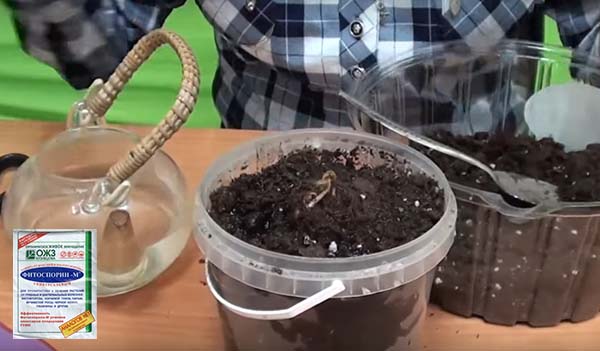
- Top up with soil.
There is no need to disturb the plant any more, just water it promptly as the soil dries up. Top dressing is not required at this stage.
It remains only to put the container with the astilba seedling in a bright and cool room, where the air temperature is kept within + 15-18 degrees.
Video: how to plant astilba that you bought early and want to save before landing in the ground
Planting astilba in open ground
Landing dates
Boarding times vary depending on where you live. As always, the inhabitants of the Middle Belt (Moscow region) begin to plant earlier than the gardeners of the Urals and Siberia, but much later than the southern regions.
Astilbe in open ground, as a rule, is planted no earlier than May, when the ground warms up enough. And it doesn't matter if you plant rhizomes with renewal buds or plant seedlings.
In general, astilbe can be planted both in spring and autumn, and even in summer, if, of course, the weather is not very hot. It all depends on when you can get the planting material.
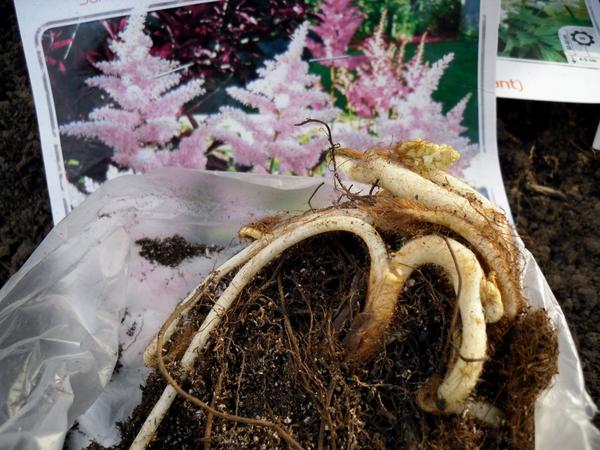
Place and soil on the site
In order for astilbe to delight you with its lush flowering, you need to find the optimal place on the site for planting it.
Astilba can grow both in the shade and in the sun. But still this plant likes to grow in partial shade on loose and moist soils. It is optimal to plant the plant in soil with a predominant clay content and
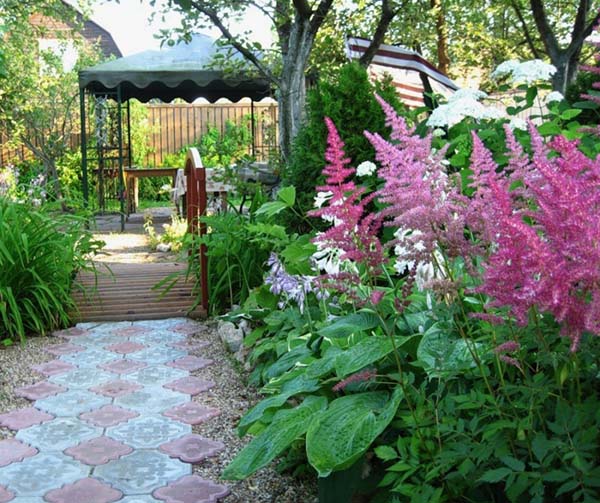
As for a specific place, if you have a small body of water on your site, then plant it nearby. If not, then the area on the north side of the house, as well as shady places next to trees and shrubs, is perfect for landing.
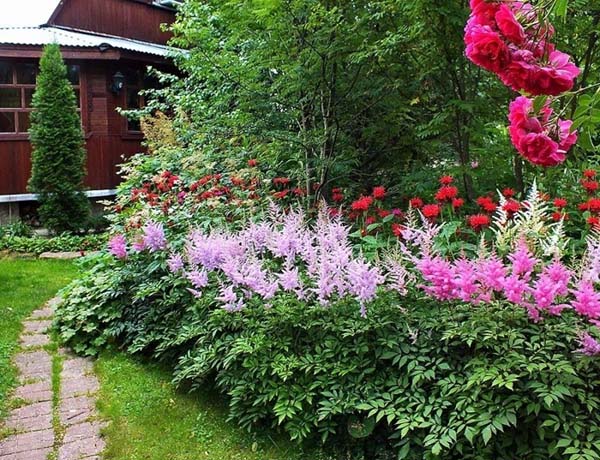
By the way! To accurately determine the place for planting astilba, you should pay attention to the flowering period of a particular plant variety. For example, early and late flowering can grow successfully both in the shade and under the scorching sun. But mid-flowering (also called July), it is advisable to plant in shady areas. If you want to extend the flowering period of varieties with white and pink flowers, then it is advisable to plant them in partial shade as well.
Direct landing in the garden
For planting astilba in open ground, it is worth preparing a landing hole in advance, making it about 20-30 centimeters deep. A little should be added to the land for planting wood ash, compost or humus, and then mix it all very thoroughly and water abundantly. Next, plant a seedling, sprinkle it with earth, and then mulch it to better retain moisture with a layer of about 3-5 centimeters. Peat, tree bark can be used as mulch, sawdust or the same straw.
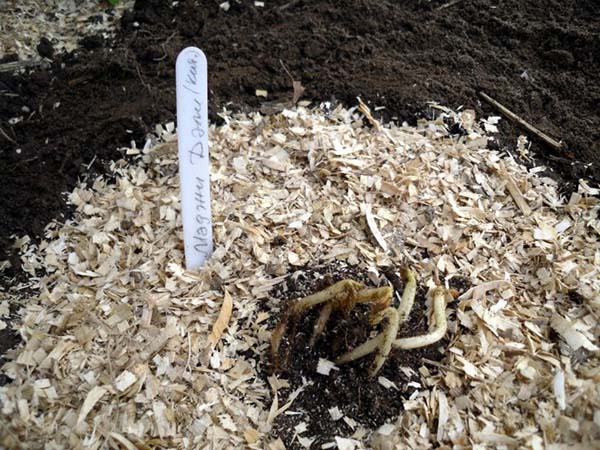
By the way! Although this plant is not very sensitive to the soil, but by planting it in a pre-fertilized place, you will not need to feed it for a while. However, it will grow much better, which means that the flowering will be more magnificent and brighter.
As for the astilba planting scheme, the high varieties are planted at a distance of about 0.5 meters, and the low ones - about 0.2-0.3 meters.
Outdoor care for astilba
Astilba care consists in regular watering, depending on the weather and timelyhilling... The latter is required due to the fact that the roots of the plant constantly grow upward, while their lower part dies off over time.

Astilba loves moisture, so do not forget about watering and try to prevent the soil from drying out, especially in hot late spring and summer periods. If the weather is dry and the sun is simply incinerating, then watering is recommended at least 1, or better even 2 times a day.
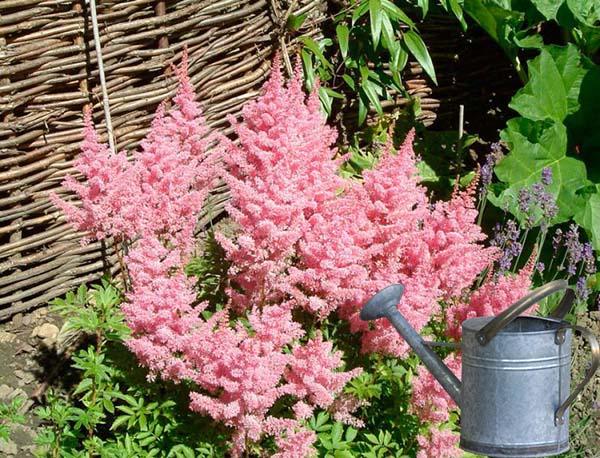
Top dressing
Astilba fertilizing is carried out in the spring, in the summer - before and after flowering, as well as in the fall.
Note! Before applying top dressing, the plant must first be watered. If it was raining before, then additional moisture is not required.
Spring feeding is carried out using nitrogen fertilizers to build up green mass by the plant. For example, you can add a little humus to the ground, for example, during hilling. Or it is great to use mullein infusion for these purposes.

In summer, before flowering, the plant requires potassium fertilization. For this, potassium nitrate, 2 tbsp. l. which must be dissolved in 10 liters of water. The consumption rate is approximately 0.5 liters per 1 bush.

At the end of summer, after flowering, the shrub requires phosphorus fertilization. To do this, you can perform dry dressing. superphosphate: about 1 tbsp. spoon for 1 bush.
Advice! After finishing any of the dressings, the soil near the shrub should be thoroughly loosened and mulch added.
Autumn care and preparation for winter
After flowering, it is recommended to cut off the arrows of faded peduncles. They do not represent any aesthetic value (although many growers like them), and the plant spends useless energy on planting seeds.

Important! For more information about the autumn care of astilba and its preparation for winter, you can read here.
If you have already succumbed to the delicate charm of fluffy astilba, let it occupy its niche in your flower bed in your own garden! And you already know how and when to plant it correctly and properly care for it.
Video: astilba - growing, care and reproduction


